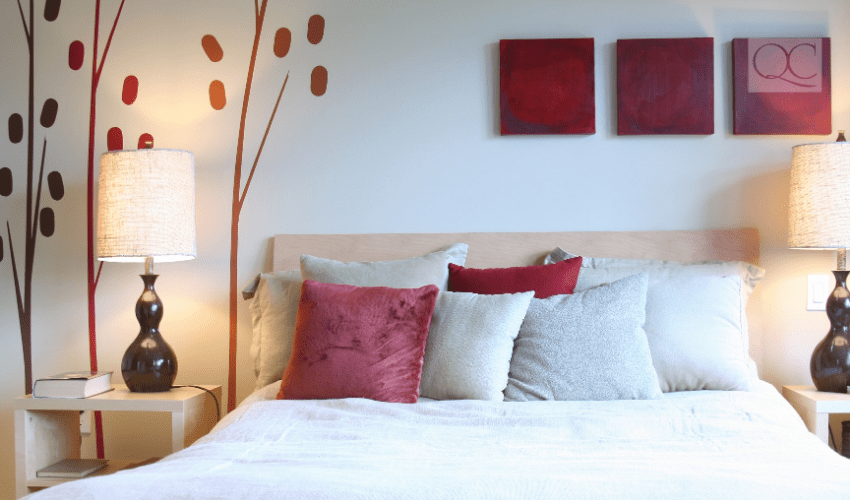Brand-new to the Feng Shui bagua map? QC Design School tutor, Ivy Ellerby, reveals 4 mistakes you NEED to avoid making!
The founder of Eastern Design and Home Staging, Ivy is an Accredited Staging Professional and Advanced Feng Shui Design Professional. As a renowned industry expert, Ivy uses her knowledge to help consumers increase profits on home sales and implement new design ideas into their living spaces.

What is Feng Shui Bagua?
The Feng Shui bagua is an energy map. It’s one of the most powerful tools used in Western-based Feng Shui practices. This is due to the fact that it offers a systematic way to evaluate the energy field of your environment.
However, this tool is only as good as the person who’s using it. If you don’t know what your doing, it won’t work properly. Here are some of the most common mistakes that people make when using the Feng Shui bagua map…
4 Critical Mistakes to Avoid
Mistake #1: Don’t Overanalyze a Space.
Use the Feng Shui bagua to balance energy in a space – but don’t overuse it. If you’re analyzing the first floor of a home, it’s okay to analyze it further by applying the bagua map to a specific area of the house. Just keep in mind that this additional area should still relate to the same concern being addressed for the first floor.
The mistake is made when you keep going beyond that. You don’t want to get SO specific that you create even more issues than what was initially present. For example, say a client hires you to help them. They have a career goal of finding a job that pays more money.
First, you’d apply the bagua to the main floor of the home. This will give you an overall reading of what’s going on. Ensure to pay special attention to the career and abundance guas. Next, you may then decide to take a reading of the client’s home office. After all, you’ll want to make sure that the room directly related to work is balanced and supports your client’s goals.
At this point, here’s what you DON’T want to do: apply the bagua to your client’s desk, computer desktop screen, mobile phone screen, and so on. This would make your client crazy and paranoid! Remember: the changes we make based on a Feng Shui bagua reading will help to serve as reminders of what we should be focusing on throughout the day. These focuses, of course, should be on balance, harmony, and satisfaction in all areas of life.

Mistake #2: Don’t Mix The Feng Shui Bagua Map With The Classical Flying Stars Energy Map.
One of the BIGGEST problems I see with people who are “self-taught” in Feng Shui design is that they mix processes from completely different schools of thought. What happens when they do this? Well, they normally end up attempting many processes that have no results. As a result, they’re misled into believing that Feng Shui doesn’t actually work.
As a tutor of QC Design School, my students often ask which school of Feng Shui they’re learning. I explain that QC’s Feng Shui Design Course exposes them to many different schools of Feng Shui. We do this so that our students can then choose which school resonates most with their beliefs and understanding. Typically, one school of thought will make more sense than the others. As such, that will probably be the school they primarily focus on in their business.
To further explain this point, I’ll give the example of weight loss. There are many different ways of losing weight: exercise, calorie restriction, surgery, pharmaceutical drugs, or a combination of these. No matter which way a person chooses to lose weight, the ideal end result is the same: weight loss.
The same is true for the various schools of Feng Shui. We all balance energy to support our clients’ needs, but the way we complete the process is often times very different. This is precisely why you must start and finish an energy analysis the same way! Being well-trained on how to use these energy maps is critical to balancing energy and helping our clients.
Mistake #3: Not Allowing Creativity and Variations in Bagua Colors, Based on Client.
The Feng Shui bagua is, in essence, a guide to finding and maintaining balance. There are colors and elements that are provided, in order to give the Feng Shui Consultant guidelines on which energies need to be present.
However, sometimes you’ll have a client who is not fond of the element or color that needs to be present. In such a scenario, you must become creative! You’ll need to find subtle – yet effective – ways of incorporating those elements and colors into their space – while still respecting the client’s wishes.
A Personal Example…
Let’s look at the Relationship gua as an example. I once had a man who hired me to balance his home. He has not been able to maintain any romantic relationships for longer than 6 months. Moreover, he was not sleeping well. These were the issues he wanted my help with addressing.
When I went to his home, his entire bedroom furnishings were overly-stated in red. The Feng Shui bagua indicates that this area should be pink. Now, let me remind you that my client was a 57-year-old, single male. There was no way he would have his bedroom changed to pink. So, I had to get creative. I needed to somehow incorporate the energy of pink, in a way that supported his feelings and personal preferences.

Fixing the Problem
One thing was clear, though: the overwhelming amount of red needed to go. Having a bedroom covered in red creates an energy of raised tempers, arguments, and bickering. I used this as my starting point. I decided the smartest way to proceed was to add some white to this red room. Since my client was an avid art collector, one of the things we decided to do was find an amazing piece of art that was all white.
My client ended up finding an oversized, beautiful canvas online. This piece was called, “Eternal Light, Eternal Love”. He was really excited to add it to his bedroom! Once I explained that all of the red in his room was probably a source of his sleep disruption, he agreed to tone down some of the red.
The changes we made in his bedroom were small. However, they were enough – and effective! They allowed my client to become aware of how he reacted to new love interests whenever they disagreed about something. By becoming aware of this, he could ensure going forward that similar situations would not escalate or be blown out of proportion.
The new, supportive energy present in the room was enough to assist him in maintaining these new thoughts. Those small shifts in his bedroom changed his focus, and therefore, his outcomes!
Mistake #4: Don’t Over-Explain the Feng Shui Bagua Map to Clients.
Feng Shui is both an art and a science. It takes a very long time to master! There’s always something new to learn and expand your knowledge on, even when presented with the same information over and over again. The Feng Shui bagua map contains more information than you’ll probably ever use in your entire life.
Yes, you will become comfortable with the information you use over and over again with your clients. As your career progresses, you’ll probably become a seasoned expert in certain areas of the bagua map. But some of the knowledge will rarely, if ever, be used by you.
There are two types of Feng Shui Consultants:
- The one who learns lots of information about specific areas of focus, such as health and wellness;
- And the one who learns a little bit of information about a lot of topics related to Feng Shui.
The Difference Between You and Your Clients

Regardless of which category you fall under, what you know will probably always be more than what your clients know. It’s important to remember that you’re the expert, whereas they are the ones seeking assistance. If they knew what you know, they wouldn’t need your help. Thus, a lot of what you explain to them will be brand-new information, terms, and concepts.
Part of your job as a consultant is to know which pieces of information to share with a client – versus which information you should keep to yourself. Not every client will be ready to hear all of the information you have readily available. Always know where to stop. Give enough information to satisfy their questions and meet them at their skill-level.
For example, one of your clients could be a Reiki master. That doesn’t necessarily mean that they understand energy any better than a client who is completely new to Feng Shui. However, they might be more inclined to request deeper insight into what you’ve discovered during your Feng Shui bagua analysis.
Just remember: you need to leave this decision up to client. Provide a more advanced analysis if it’s requested of you, but don’t spring it upon them otherwise.
Interested in launching a career as a Feng Shui designer? QC Design School’s online Feng Shui Course offers you an opportunity to learn how to correctly use the Feng Shui bagua, so that you can go out into the real world and change your clients’ lives!


